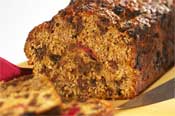HALLOWE'EN - Oaty Cider Brack / Sausages with Quick Barbecue Sauce / Kale
 There is something about Hallowe'en that brings out the traditional in us - maybe it's because there are so many traditions associated with it (and not just way back in the past either), or that there's such a sense of the changing seasons. The fact that schools are on half term might have something to do with it too - there's certainly more time to be messing around in the kitchen rustling up big batches of colcannon and all those other old-fashioned treats.
There is something about Hallowe'en that brings out the traditional in us - maybe it's because there are so many traditions associated with it (and not just way back in the past either), or that there's such a sense of the changing seasons. The fact that schools are on half term might have something to do with it too - there's certainly more time to be messing around in the kitchen rustling up big batches of colcannon and all those other old-fashioned treats.
So why not try this brack over the weekend and have it ready for Hallowe'en - it's fun to include all the charms too.
Oaty Cider Brack
This version of the traditional brack is especially delicious toasted and spread with cinnamon butter; heating the fruit and cider together makes it very juicy - and the oats give the texture a bit more bite than usual.
The ring signifies an early marriage, of course, but you can also include other object intended to divine the future: a small silver coin (wealth), a button (bachelorhood), a thimble (spinsterhood), a chip of wood (a stormy marriage) and a rag (poverty) - these days all hygienically wrapped in foil.
Instructions are given for the traditional round brack, but the mixture could also be divided between two loaf tins if preferred.
8 oz/225g raisins
8 oz/225g sultanas
6 oz/175g dark soft brown sugar
1/2 pint/300 ml cider
2 oz/50g flaked oats
4 oz/100g mixed peel
Grated rind of l orange
4 oz/100g butter, melted
2 eggs, lightly beaten
14 oz/400g plain flour
2 level teaspoons baking powder
l teaspoon mixed spice
1/2 teaspoon cinnamon
Pinch of salt
Ring etc, wrapped in greaseproof paper or foil (optional)
l tablespoon sugar and 2 tablespoons cider to glaze.
Put the raisins, sultanas and brown sugar into a saucepan with the cider. Over gentle heat, bring up slowly to boiling point, stirring occasionally, then allow to cool - leave overnight if convenient.
Preheat a moderate oven 350'F, 180'C, gas mark 4. Grease and base-line a 9"/22.5 cm round deep cake tin.
Add the oats, mixed peel and grated orange rind to the mixture, along with the melted butter and lightly beaten eggs. Sieve the dry ingredients together and gradually stir into the fruit mixture. Stir well, making sure all the ingredients are thoroughly mixed together. Add the ring and other charms, if using. Turn the mixture into the prepared tin and bake for 11/2-2 hours, until the top of the cake feels firm to the touch.
Remove from the oven and brush with a glaze made by bringing the cider to the boil in a small pan and dissolving the sugar in it. Return the brack to the oven for about 3 minutes, until the top is shiny brown.
Cool in the tin. When cold, remove the lining paper and store in an airtight tin until required.
Serve sliced and buttered, or toasted and spread with cinnamon butter (butter with a little ground cinnamon worked into it).
SHORT RECIPE: Sausages with Quick Barbecue Sauce
 These big juicy sausages are great for a hungry family at any time, but seem just right for Hallowe'en. They can be cooked on a barbecue, grilled or cooked in the oven, whichever is handiest, and the sauce can be used in cooking and/or at the table.
These big juicy sausages are great for a hungry family at any time, but seem just right for Hallowe'en. They can be cooked on a barbecue, grilled or cooked in the oven, whichever is handiest, and the sauce can be used in cooking and/or at the table.
Serves 4:
8 best quality jumbo sausages
Quick Barbecue Sauce:
Mix together: 4 tablespoons tomato ketchup and 1 tablespoon each of honey, wine vinegar, and Worcestershire Sauce. Add a dash of Tabasco, and season to taste with salt and pepper.
Simmer the jumbo sausages for 2-3 minutes in boiling water just before cooking; this will remove excess fat and reduce the cooking time needed. Preheat the grill or barbecue and spread a little barbecue sauce on the sausages. Grill for about 6-7 minutes on each side, keeping them a reasonable distance from the heat so that they don't burn before they are cooked through. Serve with colcannon or mash, and any remaining barbecue sauce.
INGREDIENT OF THE WEEK: KALE
 What Is It?
What Is It?
Kale, brassica oleracea, is a member of the cabbage family; a hardy biennial plant grown as an annual winter-green vegetable. There are two forms, plain and curled.
Where Does It Come From?
It is regarded as a native plant, although probably brought to these islands by the Saxons; the form we know is developed from wild cabbage, and can be grown in difficult areas, eg on exposed sites. You need to have a large garden to grow it, although compact varieties are available, and some are quite ornamental - 'Cottager's' for example, is a a plain-leaved variety with crimp-edged purple tinged leaves. There is also a black form, knows as cavolo nero; it is used a lot in Tuscany and has become very trendy.
Where Can I Get It?
At this time of year it is piled up in every supermarket and corner shop in Ireland. After Hallowe'en there is less of it around, although it is available throughout the winter from greengrocers, farmers' markets and supermarkets.
What Can I Do With It?
Its main use at this time of year is in traditional colcannon, but it can be used as a green leaf vegetable all winter. To prepare, cut the hard bottom off the stem, wash the leaves well, trim any remaining tough stem and chop the leaves. Cook in a large pan of boiling salted water for 5 minutes, then drain well. To use it in colcannon, mash the cooked kale with peeled boiled potatoes, plenty of butter and seasoning. To use as a green vegetable. it is tastiest if pan-finished - melt some butter in a pan over medium heat, stir in the well-drained cooked kale, season well and warm through thoroughly, then serve as a side vegetable in the same way as cabbage.





There are currently no comments
Leave a comment
Not a member? Register for your free membership now!
Or leave a comment by logging in with: